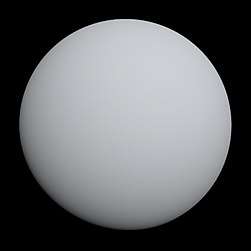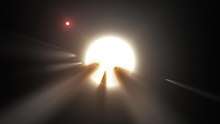Kepler-445c
Kepler-445c is an exoplanet orbiting the red dwarf star Kepler-445 every 5 days in the inner edge of the star's circumstellar habitable zone.[2] PHL has currently not assessed the planet for habitability.[3]
| Discovery | |
|---|---|
| Discovery site | Kepler Space Observatory |
| Discovery date | 2015 |
| Transit | |
| Orbital characteristics | |
| 0.033427 AU (5,000,600 km) | |
| Eccentricity | 0 |
| 4.871229±0.000011 d | |
| Inclination | 89.91 |
| Star | Kepler-445 |
| Physical characteristics | |
Mean radius | 2.51 R⊕ |
| Temperature | 362 K (89 °C; 192 °F) [1] |
Physical features
| Earth | Kepler-445c |
|---|---|
 |
 |
With a radius of 2.5 times that of Earth, it is likely a water world or even a mini-Neptune if it has a gaseous composition. Assuming that Kepler-445c has the same density of Earth, it would have a mass of 15.9M⊕, according to the PHL exoplanet density calculator
gollark: Void the warranty because of it I mean.
gollark: I don't think they can do that.
gollark: Are you still here?
gollark: Please ask your question instead of asking to ask your question.
gollark: I've added a neat statically generated "content from other blogs" bit to my website.
References
- http://exoplanetarchive.ipac.caltech.edu/cgi-bin/TblView/nph-tblView?app=ExoTbls&config=cumulative&constraint=koi_pdisposition+like+%27CANDIDATE%27
- http://exoplanetarchive.ipac.caltech.edu/cgi-bin/DisplayOverview/nph-DisplayOverview?objname=Kepler-445+c&type=CONFIRMED_PLANET
- http://phl.upr.edu/projects/habitable-exoplanets-catalog
This article is issued from Wikipedia. The text is licensed under Creative Commons - Attribution - Sharealike. Additional terms may apply for the media files.


